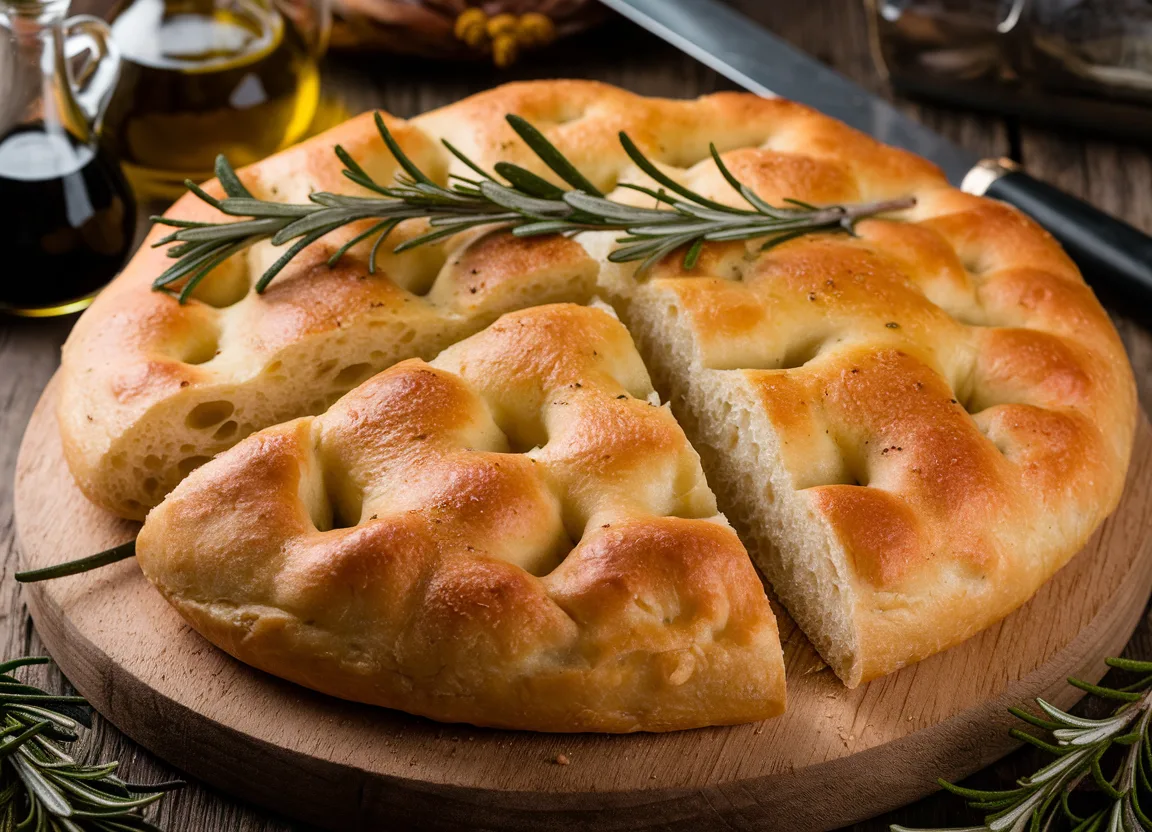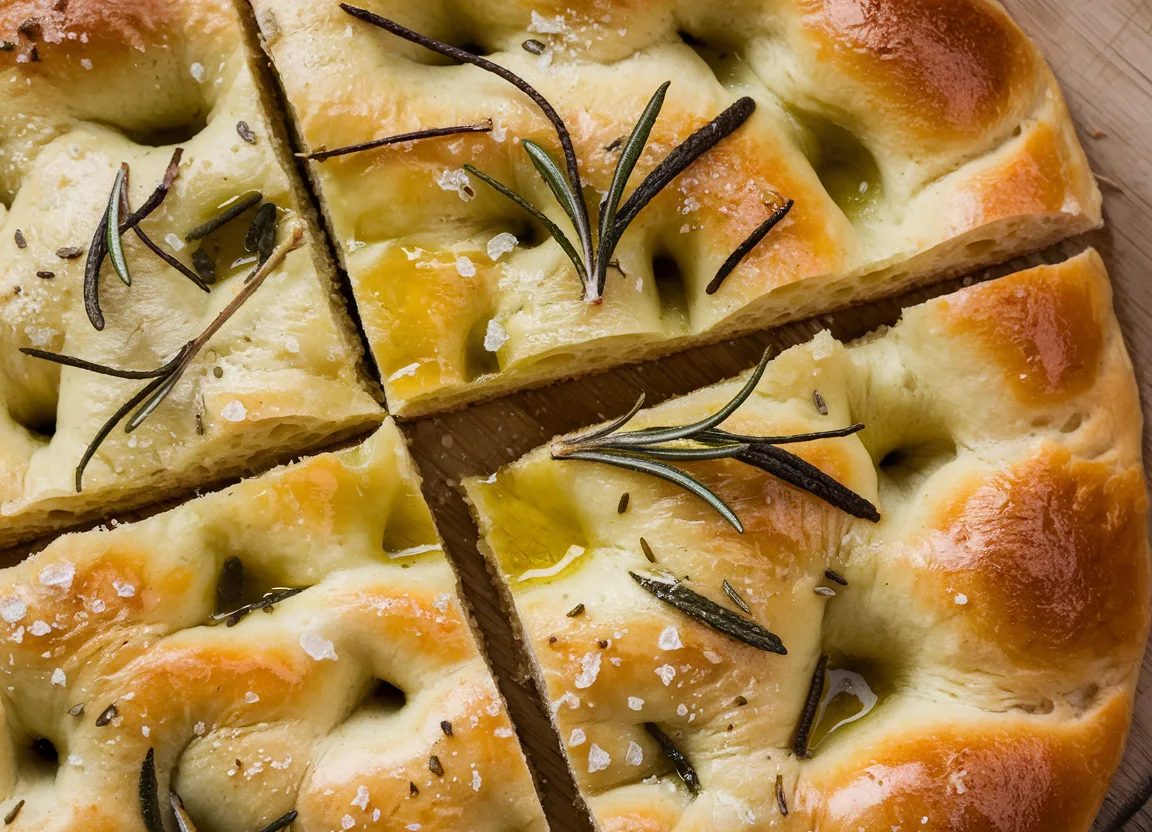Focaccia is a beloved Italian bread, known for its versatility and delightful flavors. Its simplicity is its strength, allowing for a myriad of variations.
Classic focaccia is often adorned with rosemary, sea salt, and olive oil. Yet, the world of focaccia extends far beyond these traditional toppings. From savory to sweet, the possibilities are endless.
In this guide, we’ll explore the many faces of focaccia. We’ll delve into its classic forms, creative variations, and adaptations for special diets. We’ll also look at different ways to shape and bake this versatile bread.
Whether you’re a seasoned home baker or a novice in the kitchen, this guide will inspire you. It will equip you with the knowledge to experiment with your own focaccia creations.
So, let’s embark on this journey of flavors and textures. Let’s discover the joy of baking and the endless variations of focaccia.
The Basics of Focaccia
Before we dive into the variations, let’s understand the basics of focaccia. This bread has its roots in ancient Rome, where it was known as “panis focacius.” The name comes from the Latin word “focus,” meaning hearth or fireplace.

What is Focaccia?
Focaccia is a flat, oven-baked Italian bread. It’s similar to pizza dough in composition, but typically has a higher olive oil content. This gives it a rich flavor and a slightly crispy exterior.
The interior of focaccia is soft and airy. This is achieved through a process of multiple risings and gentle handling of the dough.
The Key Ingredients
The basic ingredients for focaccia are simple: flour, water, yeast, salt, and olive oil. The quality of these ingredients plays a significant role in the final taste and texture of the bread.
Olive oil is particularly important. It’s not only used in the dough but also drizzled on top before baking. Infusing the oil with herbs and spices can add an extra layer of flavor.
The Importance of Dimpling
One distinctive feature of focaccia is its dimpled surface. These dimples are created by pressing fingers into the dough before baking. They serve a practical purpose.
The dimples create pockets that hold olive oil and toppings. They also contribute to the bread’s unique texture. So, don’t skip this step when making your focaccia. It’s part of what makes this bread so special.
Classic Focaccia Toppings
Now that we’ve covered the basics, let’s explore some classic focaccia toppings. These are the traditional flavors that have stood the test of time. They’re simple, yet incredibly satisfying.

Rosemary and Sea Salt
Rosemary and sea salt is a classic focaccia topping combination. The aromatic rosemary pairs beautifully with the crunch of sea salt flakes. This is a simple yet flavorful option that lets the taste of the bread shine through.
When using rosemary, fresh is best. It gives a more vibrant flavor than dried. As for the salt, opt for flaky sea salt over table salt. It provides a better texture and a more nuanced taste.
Olive and Tomato
Another classic topping combination is olive and tomato. The sweetness of ripe tomatoes contrasts with the salty, briny flavor of olives. This creates a balanced and delicious topping for your focaccia.
When choosing tomatoes, go for ones that are ripe but still firm. This ensures they hold up during baking. As for the olives, you can use green or black, or a mix of both for added color and flavor.
Garlic and Herb
Garlic and herb is a versatile topping that pairs well with many dishes. The garlic adds a punch of flavor that’s mellowed by the herbs. This is a great option if you’re serving the focaccia as a side dish with pasta or soup.
You can use any herbs you like, but some good options are thyme, oregano, and basil. Fresh herbs will give the best flavor, but dried herbs can work in a pinch. Just remember to use them sparingly as their flavor is more concentrated.
Creative Savory Variations
While classic toppings are always a hit, don’t be afraid to get creative. There are countless savory variations to try. Here are a few ideas to inspire your next focaccia baking session.

Cheese and Onion Focaccia
Cheese and onion is a winning combination. The sweetness of caramelized onions pairs perfectly with the salty, melty cheese. This is a hearty option that’s perfect for a filling snack or a side dish.
Choose a cheese that melts well, like mozzarella or cheddar. For the onions, slow cook them until they’re caramelized to bring out their natural sweetness.
Potato and Rosemary Focaccia
Potato and rosemary focaccia is a hearty and satisfying variation. Thinly sliced potatoes become crispy in the oven, adding a delightful texture to the soft focaccia. Rosemary adds a fragrant touch.
Use a mandolin to slice the potatoes thinly and evenly. This ensures they cook evenly and become perfectly crispy.
Mediterranean Vegetable Focaccia
For a lighter option, try a Mediterranean vegetable focaccia. Topped with a colorful array of vegetables, this is a healthy and delicious choice. It’s like a salad and bread in one!
Use any vegetables you like, but some good options are bell peppers, zucchini, and eggplant. Slice them thinly and arrange them on the dough before baking.
Meat Lover’s Focaccia
For the carnivores out there, a meat lover’s focaccia is a must-try. Topped with a variety of meats, this is a hearty and satisfying option. It’s almost like a pizza, but with the soft, fluffy texture of focaccia.
Choose a variety of cured meats for the best flavor. Some good options are salami, prosciutto, and pepperoni. Just remember to slice them thinly so they cook evenly.
Sweet Focaccia Treats
Focaccia isn’t just for savory toppings. It can also be a canvas for sweet treats. The fluffy, slightly salty bread pairs wonderfully with sweet toppings, creating a delightful contrast.
Grape and Sugar Focaccia
Grape and sugar focaccia is a classic Italian treat. The grapes become juicy and sweet in the oven, creating a delicious contrast with the salty bread. It’s a simple yet satisfying dessert or snack.
Use seedless grapes for the best results. Sprinkle the dough with a generous amount of sugar before baking to create a sweet, caramelized crust.
Honey and Fig Focaccia
Honey and fig focaccia is a sophisticated and delicious variation. The figs become jammy and sweet in the oven, and the honey adds a touch of floral sweetness. It’s a perfect dessert for a dinner party or a special treat for yourself.
Use fresh figs when they’re in season for the best flavor. Drizzle the focaccia with honey before and after baking for a glossy, sweet finish.
Apple Cinnamon Focaccia
Apple cinnamon focaccia is like a fluffy, delicious apple pie. The apples become soft and sweet in the oven, and the cinnamon adds a warm, spicy note. It’s a comforting and delicious treat that’s perfect for fall.
Use tart apples like Granny Smith for the best flavor contrast. Sprinkle the dough with a mixture of sugar and cinnamon before adding the apples for a sweet, spiced crust.
Special Diet Focaccia Variations
Focaccia is a versatile bread that can be adapted to suit various dietary needs. Whether you’re gluten-free, vegan, or just looking for a healthier option, there’s a focaccia variation for you.
Gluten-Free Focaccia Options
Gluten-free focaccia is not only possible but also delicious. The key is finding the right blend of gluten-free flours. A mix of rice flour, potato starch, and tapioca flour often works well.
Xanthan gum is also crucial. It helps to bind the ingredients together and create a chewy texture similar to traditional focaccia.
Vegan Focaccia Variations
Vegan focaccia is easy to make. The basic focaccia dough is already vegan, made with flour, water, yeast, and olive oil. The challenge comes in choosing vegan toppings.
Olives, tomatoes, and herbs are all great vegan options. For a cheese-like flavor, try sprinkling nutritional yeast on top before baking.
Whole Wheat and Healthy Twists
Whole wheat focaccia is a healthier twist on the classic bread. It has a slightly nuttier flavor and a denser texture, but it’s just as delicious.
You can use 100% whole wheat flour, or mix it with white flour for a lighter texture. Adding seeds like flax or sesame can also boost the nutritional value and add a nice crunch.
Focaccia in Different Forms
Focaccia is not limited to a flat, rectangular shape. It can take on various forms, from muffins to rounds, depending on the pan you use. This versatility makes focaccia a fun and adaptable bread to bake at home.
Focaccia Muffins
Focaccia muffins are a delightful twist on the traditional bread. They’re portable, easy to serve, and perfect for individual portions.
To make focaccia muffins, simply divide the dough into a greased muffin tin. You can top each muffin with different ingredients for a variety of flavors in one batch.
Using Different Focaccia Pans
The type of pan you use can also influence your focaccia. A standard baking sheet will give you a thin, crispy focaccia, perfect for sandwiches or pizza.
For a thicker, fluffier focaccia, try using a deeper pan. A cast-iron skillet can also be used for focaccia, resulting in a crispy bottom crust and a soft, airy interior.
Tips for Perfect Focaccia Every Time
Baking the perfect focaccia requires a bit of know-how. From the right oven temperature to proper dough handling, these tips will help you achieve a delicious result every time.
The Right Oven Temperature
A well-preheated oven is crucial for achieving the perfect focaccia crust. Most recipes call for an oven temperature of around 200°C (400°F).
Ensure your oven is fully preheated before baking. This helps create a crispy, golden crust and a soft, airy interior.
Hydration and Dough Handling
The hydration level of your dough can greatly affect the texture of your focaccia. A higher hydration leads to a lighter, airier bread.
Handle the dough gently to preserve the air pockets. Dimpling the dough before baking also helps create those characteristic pockets that hold olive oil and toppings.
Serving and Pairing Suggestions
Focaccia is incredibly versatile when it comes to serving and pairing. It can be used as a side dish, sandwich bread, or even as a pizza base.
For a classic serving suggestion, try pairing focaccia with dips such as balsamic vinegar and olive oil. It also pairs well with a variety of wines, from crisp whites to robust reds.
Conclusion
Focaccia is a versatile bread that invites creativity. With its endless variations in toppings, flavors, and forms, it’s a bread that never gets boring.
Whether you’re a seasoned baker or a beginner, focaccia offers a rewarding baking experience. So, roll up your sleeves, get your hands in some dough, and start exploring the wonderful world of focaccia.
